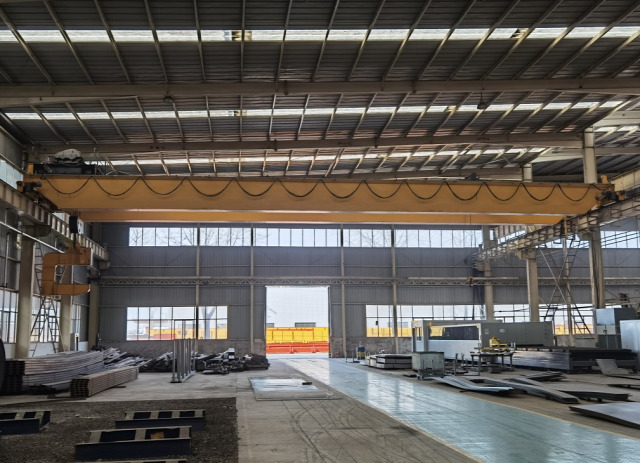Double girder overhead cranes are essential lifting equipment widely used in industries such as manufacturing, construction, and logistics. As with any heavy machinery, ensuring safety and compliance with regulations is paramount to protect workers, maintain efficient operations, and prevent accidents. In this article, we will explore the regulations and standards that govern double girder overhead cranes, highlighting their importance and the measures required to ensure compliance.
Occupational Safety and Health Administration (OSHA) Standards:
The Occupational Safety and Health Administration (OSHA) sets forth regulations and standards in the United States to ensure safe working conditions. OSHA's general requirements for overhead cranes include specifications for design, inspection, testing, and maintenance. These standards outline factors such as load capacities, clearances, emergency stop systems, and operator training requirements.

American National Standards Institute (ANSI):
The American National Standards Institute (ANSI) provides guidelines and standards for the design, construction, testing, and operation of overhead cranes. ANSI B30.2 and B30.17 standards specifically address the safety requirements for overhead and gantry cranes, covering aspects such as design, load rating, safety devices, and maintenance.
Crane Manufacturers Association of America (CMAA):
The Crane Manufacturers Association of America (CMAA) provides industry-specific standards for overhead crane design, construction, installation, and safe operation. The CMAA Specification 70 sets forth guidelines for Class A, B, C, and D cranes, addressing load capacities, structural requirements, and safety considerations.
European Standards (EN):
In Europe, double girder overhead travelling cranes must comply with European Standards (EN). EN 13001-1 and EN 13001-2 specify the general design principles and requirements for cranes, including the calculation of loads, safety devices, and electrical components. EN 15011 provides guidelines for the maintenance, inspection, and testing of cranes.
International Organization for Standardization (ISO):
The International Organization for Standardization (ISO) has developed standards that provide a global framework for crane safety and performance. ISO 4301-1 and ISO 4301-5 outline general design principles, technical specifications, and safety requirements for overhead traveling cranes, including double girder cranes.
Compliance Measures:
To ensure compliance with regulations and standards, several measures need to be implemented:
a. Design and Installation: Double girder overhead cranes must be designed, constructed, and installed by qualified professionals following the relevant standards and guidelines.
b. Regular Inspections: Conduct periodic inspections by trained personnel to assess the crane's condition, identify potential issues, and perform necessary maintenance or repairs.
c. Load Capacity and Safety Devices: Adhere to load capacity limits specified by manufacturers and ensure the crane is equipped with appropriate safety devices, such as limit switches, anti-collision systems, and overload protection.
d. Operator Training: Ensure operators receive comprehensive training on crane operation, safety procedures, and emergency protocols. Ongoing training and refresher courses are crucial to maintain competence and awareness.
e. Record-Keeping: Maintain comprehensive documentation, including inspection records, maintenance logs, operator certifications, and compliance records to demonstrate adherence to regulations and standards.
f. Compliance Audits: Regularly review internal practices and procedures to ensure compliance with relevant regulations. Engage independent third parties for compliance audits, if required.
Benefits of Compliance:
Complying with regulations and standards for double girder overhead cranes offers several benefits, including:
a. Worker Safety: Ensuring safe working conditions protects employees from accidents and injuries, promoting a positive and productive work environment.
b. Legal Compliance: Compliance with regulations minimizes the risk of fines, penalties, and legal liabilities associated with non-compliance.
c. Enhanced Efficiency: Properly maintained cranes operate efficiently, reducing downtime and maximizing productivity.
d. Extended Equipment Lifespan: Regular inspections and maintenance prolong the lifespan of the crane, minimizing the need for costly repairs or replacements.
e. Industry Reputation: Demonstrating commitment to safety and compliance enhances an organization's reputation within the industry, potentially leading to increased business opportunities.
Conclusion:
Compliance with regulations and standards for double girder overhead cranes is crucial to ensure safe operations and protect the well-being of workers. Adhering to OSHA standards, ANSI guidelines, CMAA specifications, EN requirements, and ISO standards helps maintain safety, efficiency, and legal compliance. By implementing the necessary measures such as design and installation by qualified professionals, regular inspections, operator training, and compliance audits, organizations can meet regulatory requirements, reduce accidents, and enhance overall operational success. Prioritizing safety and compliance ultimately contributes to a safer work environment, improved productivity, and the reputation of the organization in the industry.

